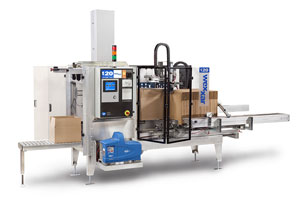Case Erectors from Lone Star Automated
7 Points to Remember

- Inline Fully Automatic Case Erector – Less redirection of the case, less jams, easier to pack.
- Primary Case Separation – The case to be formed is down on the injector – separated from the rest of the cases in the magazine. Extremely efficient.
- Pin & Dome – Revolutionary Case Opening and Squaring Mechanism. More forgiving to the imperfections of corrugated construction than any vacuum cup system.
- Simple Steps – Checking each function of the case erecting process through the PLC to improve performance and trouble shooting.
- Construction – Clear Anodized Aluminum and Stainless, Food & Pharmaceutical preferred
- Dekka Tape Heads – Stainless Tape Heads – Most Widely Integrated – Highly Engineered – Maximum uptime.
- Quick Changeover – 6 dimensional tool-less changeover points, 5-6 minute changeover time.
Key Points
- Provides a fully mechanical case opening/squaring mechanism. This is a patented feature called “Pin and Dome”. All competitive case erectors use some type of vacuum cup system for case opening and squaring. These systems are less reliable and not as effective as the pin and dome.
- This is an in-line fully automatic case erector. This keeps the flow of cases in-line and provides less margin error when processing the case. This feature delivers the cases “upright” in the same orientation that they will be packed. Many competitive systems have right angle hoppers which consume more floor space and create a higher probability for jamming because of the change in case direction through the machine
- The system captures one blank at a time for case forming. The indexing of the case is completely mechanical and only allows one case in the forming section at a time. The terminology is called “Primary Case Separation”, which creates case segregation from the other cases in the magazine. Many competitive systems use vacuum cups, pneumatic pins with brushes and/or springs to maintain case separation when forming. This method is very unreliable and requires fine tune adjustments. It also presents a problem for square cases, which in most circumstances requires the customer to “notch” the cases so separation can be achieved.
- 6 dimensional change-over points when changing case sizes and the process is completely tool-less. The change-over points may be even less depending on the dimensional differences between case blanks. Our competitors typically have between 10-16 changeover points on their systems for case erecting. Also keep in mind, that because of the Pin & Dome technology, we do not need to reposition vacuum cups for different size cases. Typical change-over time for a different case size is approximately 5-6 minutes.
- Vacuum Cup systems are less forgiving to dimensional variations in corrugated than the pin and dome system. Other problems with vacuum cup systems include but are not limited to the following: corrugated dust clogging vacuum cups, recycled content of the corrugated can effect performance, a separate set-up to properly position the cups is often required when changing case sizes, fluctuation in air volume or moisture can negatively impact a vacuum cup system. Vacuum systems are very costly to operate and maintain.
- Many case erectors square the case after it has been opened with the drive system used for bottom closure. This creates more of an opportunity for the cases to be “out-of-square”. The pin and dome system provides positive case squaring each and every time before being introduced to the drive for bottom sealing.
- Case slotting is a critical specification when looking at competitive case erectors. After squaring the case, we isolate the major flaps for minor flap folding. This allows for more variation in the slotting of an RSC.
- The case magazine is a powered in-line case transport system. This type of a case transport system is far more efficient and reliable than gravity fed “waterfall hopper” or our competitor’s powered hoppers.
- Available in both tape and hot melt glue.
- Utilizes the Dekka 22 high speed tape head (standard). Dekka provides the most reliable engineered and integrated tape head in the market.
- The “Simple Steps” processing logic adds to efficiency. These case erectors monitor, check and verify each step of the machine cycle through the PLC. If for some reason a function has not been performed, the machine stops at that point in the cycle until the problem has been resolved. This prevents unnecessary case jamming, overloading the motors and having to clear and readjust the machine.
- Center line machine that controls the case for sealing at the bottom of the case. This feature keeps the bottom flaps and closure tight across the full length of the case. This feature is especially effective with double wall cases.

